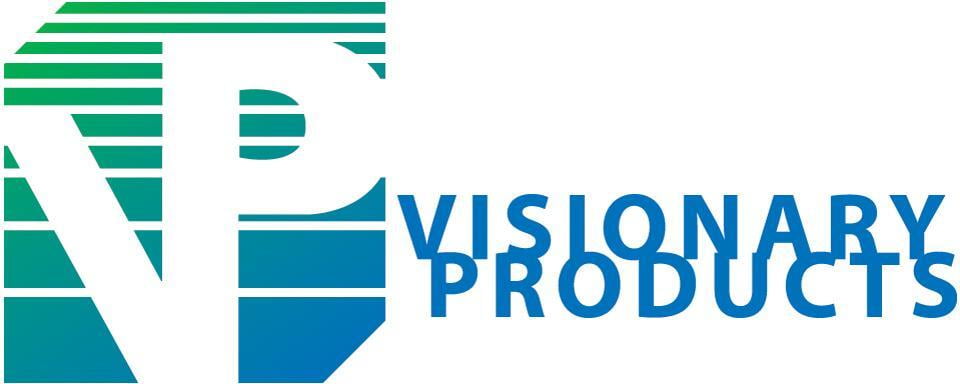Don’t go the wrong way with lean

Mark Sessumes has 30 years of operations, management and consulting experience working with organizations to accelerate their profitable growth using Innovation, Productivity, Technology and Management Systems best practices. His numerous deployment engagements designing, developing and improving products, processes and people have resulted in 100’s of millions of dollars in documented impact. His special interest is working with leadership teams to adopt management and support systems necessary for enterprise transformation.
As Director of TMAC – Metroplex, Mark has profit / loss and related performance responsibilities including Market and Sales Strategy and Execution, Product Portfolio Innovation and Management, Engagement Execution and Management, and Operations and Administration Management.
Mark has completed numerous deployments and implementations, and trained hundreds of people in transformation and Lean Enterprise techniques resulting in millions of dollars in impact. For a full biography go to: http://tmacdfw.org/team/sessumes-leadership/
Don’t go the wrong way with lean:
First of all, I consider Lean to be a strategic level initiative in the organization; specifically pursued to meet or exceed business goals. I think that the linkage to business goals is often overlooked. Often times, I have seen attempts to implement Lean as a tactical ‘project’. Someone will say, “I have a problem here,” pull out a Lean tool and try to solve that problem. While that might work for a short time, backing up and seeing the full context of how this fits into the business goals and objectives, and the systems viewpoint provides the lasting results people seek. When I think of Lean, I always think in terms of three dimensions. This can be illustrated by over-lapping circles.
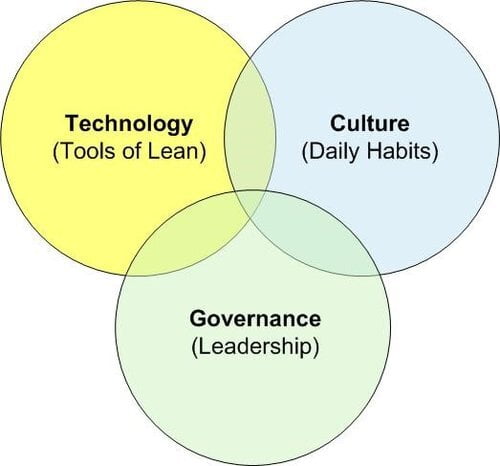
There is the Technology of Lean which can be thought of as the tool sets. These tools include things such as: Quick Change Over, Kanban, TPM or other tool sets. This is where people tend to hover. I see Lean as much more encompassing, where in a broader context, if it is to be successful, it has to also affect the culture.
By the Culture, I mean the sum of the daily habits. There are certain process changes which you can make, but ultimately they must result in a change of human behaviors. It is the behavioral changes that actually make those processes work.
Third would be the Governance or the leadership element. Management Systems and practices must go in to reinforce the culture, and to make sure that the techniques and tools take root. All three dimensions should be included in any Lean implementation.
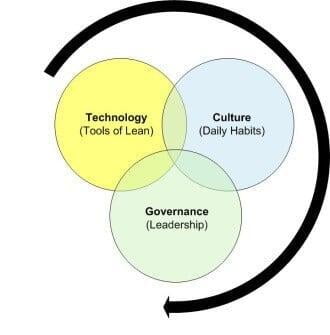
One of the biggest mistakes that I have seen in Lean deployments is when a company starts with Technology/Tools and waits to move clockwise to include Cultural and Governance development activities. Management eventually discovers that the technical tools did not sustain because the people did not ultimately change.
At TMAC, we prefer starting with Governance, and moving counter-clockwise to include Culture and Technology. We have found that it is a combination of all three areas that make Lean more effective and sustainable: Sustainable Results = Technology x Culture x Governance. If you halfway implement the Cultural and the Governance dimensions while perfectly implementing the Tools dimension, then what you end up with is a meager progression. Mathematically, you can see the results even if the Technology dimension is implemented perfectly with no mistakes or gaps: Sustainable Results = 1.0 x .5 x .5 = .25. When you start with Technology, and do not focus equally on Culture and Governance, you end up ignoring, or not appreciating the underlying structure. There is a purposeful transition from vertical management to horizontal management that happens in a true Lean implementation. Many times management is not committed to make the change from vertical to horizontal which ultimately limits the implementation success.
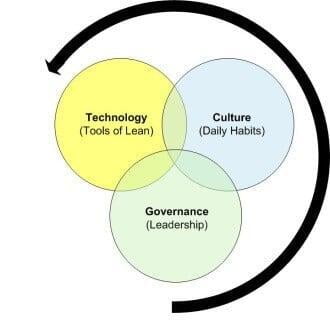
Organizations are typically structured vertically in silos: sales, marketing, production, materials management, etc. Or in departments: stamping, welding, deburring, assembly, inspection, packaging, etc. Fundamentally, how I see Lean, is you are trying to increase the velocity of the materials through the system specifically to generate revenue faster and more profitably. Normally you are attempting to accomplish this without extensive investment. You must redesign the information, product design, and supply chain, and material transformation systems and processes to enable flow. The managers in a vertical Management System work diligently to keep their area efficient, but they are not necessarily looking at the entire process flow. Related measurement systems and cultural practices also require change so everyone focuses on overall throughput speed and efficiency as the goal.
Managers and supervisors are the primary communication system between the silos in a vertical organization, but if you can take the actual doers of the work, co-locate them together, and collapse the space and time between the steps, then you are also increasing the ability to make on-the-spot decisions by operators.
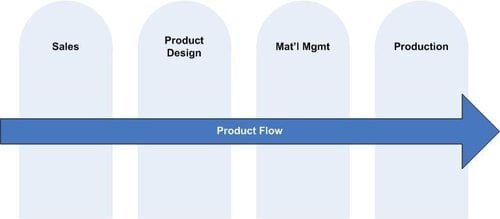
Lean can be thought of in two pieces: system design and daily improvements. The system design piece includes the leadership functions such as business goals and objectives, measurements, roles and responsibilities, etc. These help answer ‘why’ the organization is pursuing Lean in the first place. There are also different measurements that should be put in place. Remember, managers are designing the system specifically for flow. Measurement systems are typically not developed by a supervisor. These systems are ultimately the responsibilities of top leadership.
Daily improvements are driven by front-line supervisors, and are an ongoing activity for improvement. This area is the engagement side of Lean. You must have both sides to be effective. When Lean is only viewed as an engineering function, where we are going to go and ‘install it,’ it does not work. Implementing Lean is a huge undertaking when you think of all of the system design changes not just from physical changes, but also management policies which are driven by the way we think. We have to change the way we think.
When I think of a strategic initiative, I think of something on the scale of an Enterprise Resource Planning (ERP) system implementation. When you think about how massively disruptive, but yet theoretically enabling an implementation is, you can draw a parallel. First, it has the full attention of top leadership; they are fully engaged and involved. Secondly, you have clearly identified roles and responsibilities; there is no guess-work. Third, everyone in the organization is affected. Fourth, our behaviors are changed; it causes us to change how we do things. Fifth, people lose their jobs over these responsibilities. Management is serious about it. Unfortunately in many Lean implementations, it is not well understood by management and it is disconnected from the strategic goals of the business. Often, top leadership is just dabbling. They try to delegate and set up a small continuous improvement office to handle the deployment. But Lean is an organizational-level change, not a part-time, catch-as-catch can effort.
SUCCESS STORIES:
First, it is still very prevalent to hear companies that are job shops say, “This will not work for us, because we do not have a portfolio of fixed products.” Nothing can be further from the truth; I have personally seen job shops get the most benefit from Lean. The trick is in the product family analysis, determining from the entire offering of products, which ones are similar enough to be in the same family and organizing to achieve flow. I find it stimulating to see Lean implemented in ‘non-traditional’ environments.
One project that has been extremely successful is in health care. In the emergency room, the product is a well person (a person also happens to be the raw material). The goal is to produce a well person more quickly, by collapsing the arrival-to-discharge time while increasing patient care and business profitability and capacity.
Another successful project is a local blood bank. TMAC did work in the blood-processing area; from when the bags arrive until they are inventory in the refrigerator ready to go to hospitals. Blood has a limited life once drawn. Production output was increased by 66 percent with the same number of employees and the same floor space. There were also similar achievements in ancillary functions where record auditing and data entry was performed.
There were also many changes in these organizations regarding system design and in employee engagement.
In summary, Lean should be seen as a strategic initiative to transform the business to an improved value delivery system to customers, cash flow and profitability for the business, and engagement mechanism for employees. While there are specific best practices to improve production and transactional process performance, equal effort must be given to changing human behaviors, as well as management practices and thinking.
